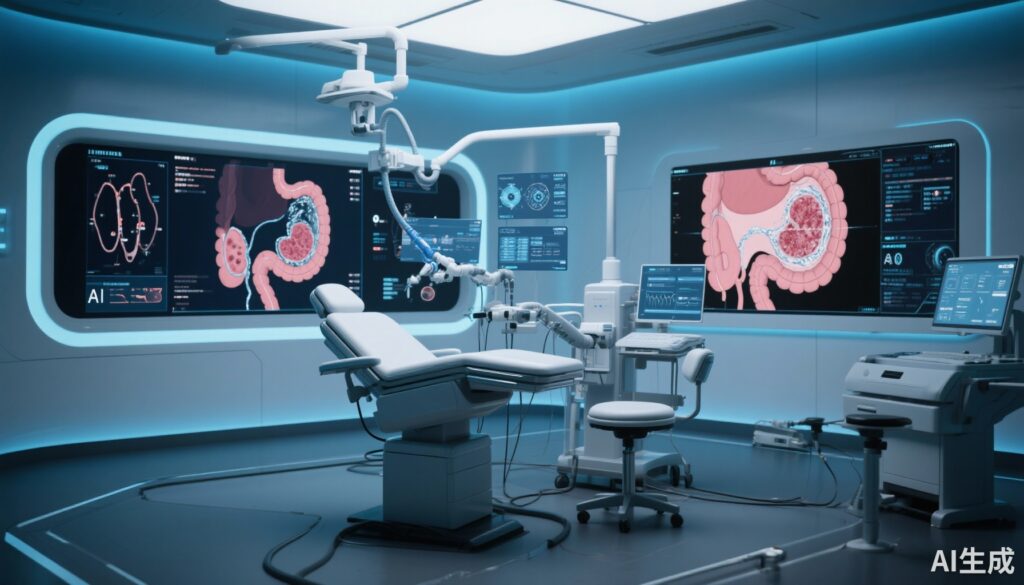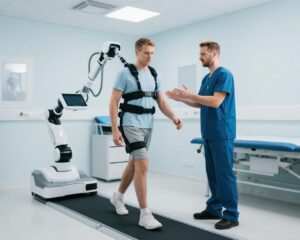Highlight
– Combining artificial intelligence-based computer-aided detection (CADe) with water exchange (WE) colonoscopy significantly increases the number of adenomas detected per colonoscopy (APC).
– This combination does not prolong withdrawal time nor increase the detection of non-neoplastic lesions.
– Despite increased APC, adenoma detection rate (ADR) and sessile serrated lesion detection rates were not significantly different, likely due to limited powering.
– Early termination of the trial was warranted based on clear interim efficacy data supporting AI integration.
Study Background and Disease Burden
Colorectal cancer (CRC) remains a leading cause of cancer morbidity and mortality worldwide. Effective screening and surveillance colonoscopy are pivotal in early detection and removal of pre-cancerous adenomas, thereby reducing CRC incidence. However, adenoma miss rates during colonoscopy remain a clinical challenge, contributing to interval cancers. Water exchange (WE) colonoscopy—a technique replacing air inflation with water during insertion—has previously demonstrated improvement in adenoma detection rates (ADR) by enhancing mucosal visualization and reducing colonic spasms. Concurrently, artificial intelligence (AI)-based computer-aided detection (CADe) systems have emerged as promising adjunct tools to assist endoscopists in identifying adenomas in real time, thereby helping reduce miss rates.
Although both WE and CADe individually show benefits in improving adenoma detection, their combined efficacy had not been rigorously evaluated. This two-center randomized controlled trial investigated whether adding CADe to WE colonoscopy could further enhance the adenomas per colonoscopy (APC) metric, a quantitative measure that accounts for both detection and multiplicity of adenomas – potentially a more sensitive outcome than ADR alone.
Study Design
This randomized controlled trial was conducted concurrently at two hospitals, one in Italy using the ENDO-AID (Olympus) system and one in Taiwan using the CAD-EYE (Fujifilm) system, thus encompassing two distinct, commercially available CADe platforms. Eligible patients were aged between 45 and 75 years and undergoing colonoscopy for screening, surveillance, or evaluation following a positive fecal occult blood test.
Patients were randomized into two groups: water exchange colonoscopy with CADe assistance (WE-CADe) and water exchange alone (WE-alone). The primary outcome was the adenomas per colonoscopy (APC) rate. Secondary outcomes included adenoma detection rate (ADR), sessile serrated lesion detection rate, withdrawal times, and detection of non-neoplastic lesions.
The planned enrollment was 752 patients, but interim analysis was conducted after reaching 560 patients, representing 75% of the planned sample.
Key Findings
The interim analysis cohort included 560 patients, with groups well-balanced in baseline characteristics (mean age 59.4 years, 299 men, 279 in the WE-CADe group).
– APC was significantly higher in the WE-CADe group (1.39 [95% CI 1.06–1.72]) compared to the WE-alone group (1.05 [95% CI 0.87–1.23]) with an incidence rate ratio (IRR) of 1.32 (95% CI 1.14–1.54), translating to an absolute increase of 0.34 adenomas per colonoscopy.
– The statistically significant improvement in APC led to early termination of the trial, underscoring the robustness of the primary outcome.
– No significant differences in ADR were observed (54.1% vs. 50.2%, P = 0.350), nor in sessile serrated lesion detection rates (3.6% vs. 3.6%, P = 0.987). This may reflect underpowering for these secondary outcomes.
– Withdrawal times were comparable between groups, suggesting that integration of AI assistance did not prolong procedure duration.
– The mean number of non-neoplastic lesions per colonoscopy was similar, indicating that AI use did not increase unnecessary polypectomies.
These findings collectively suggest that AI-assisted WE colonoscopy improves the quantitative yield of adenomas without adversely impacting procedural efficiency or specificity.
Expert Commentary
The synergistic effect seen by combining WE and AI-based CADe may be explained by complementary mechanisms: WE improves mucosal clarity and distension via water infusion, facilitating better visualization, while CADe provides real-time polyp recognition to alert endoscopists to subtle lesions.
The study’s conduct at two centers using different CADe systems enhances generalizability across platforms and populations. Early trial termination due to efficacy also highlights the ethical imperative to adopt proven interventions sooner.
However, limitations include the underpowered secondary analyses and the lack of a WE versus air insufflation comparison in this specific cohort. Furthermore, long-term outcomes such as interval cancer rates were not assessed.
Current colorectal screening guidelines increasingly recommend technologies that improve ADR, given its association with cancer prevention. While ADR did not statistically differ here, the increase in APC may translate into meaningful clinical benefits given that multiple adenomas elevate CRC risk.
Integration of AI should be accompanied by endoscopist training to fully capitalize on its potential without increasing false positives or procedure times.
Conclusion
This multicenter randomized trial validates that combining AI CADe systems with water exchange colonoscopy statistically enhances adenoma detection per procedure without increasing withdrawal time or non-neoplastic lesion resections.
These findings advocate for broader implementation of AI-assisted WE colonoscopy as a precision tool to optimize colorectal cancer screening efficacy. Future research should explore long-term outcomes, cost-effectiveness, and integration strategies in diverse clinical settings.
References
Cheng CL, Cadoni S, Gallittu P, et al. Efficacy of artificial intelligence for adenoma detection in water exchange colonoscopy: A two-center randomized controlled trial. Endoscopy. 2025 Aug 11. doi: 10.1055/a-2681-5544. Epub ahead of print. PMID: 40789324.
Rex DK, Kahi CJ. Advances in endoscopic technologies for colorectal cancer screening. Gastroenterology. 2024;166(1):26-34.
Kudo SE, Mori Y, Misawa M, et al. Artificial intelligence and colonoscopy: Current status and future perspectives. Dig Endosc. 2023;35(1):2-9.
Bisschops R, East JE, Hassan C, et al. Advanced imaging for detection and differentiation of colorectal neoplasia: European Society of Gastrointestinal Endoscopy (ESGE) Guideline. Endoscopy. 2019;51(4):365-377.



